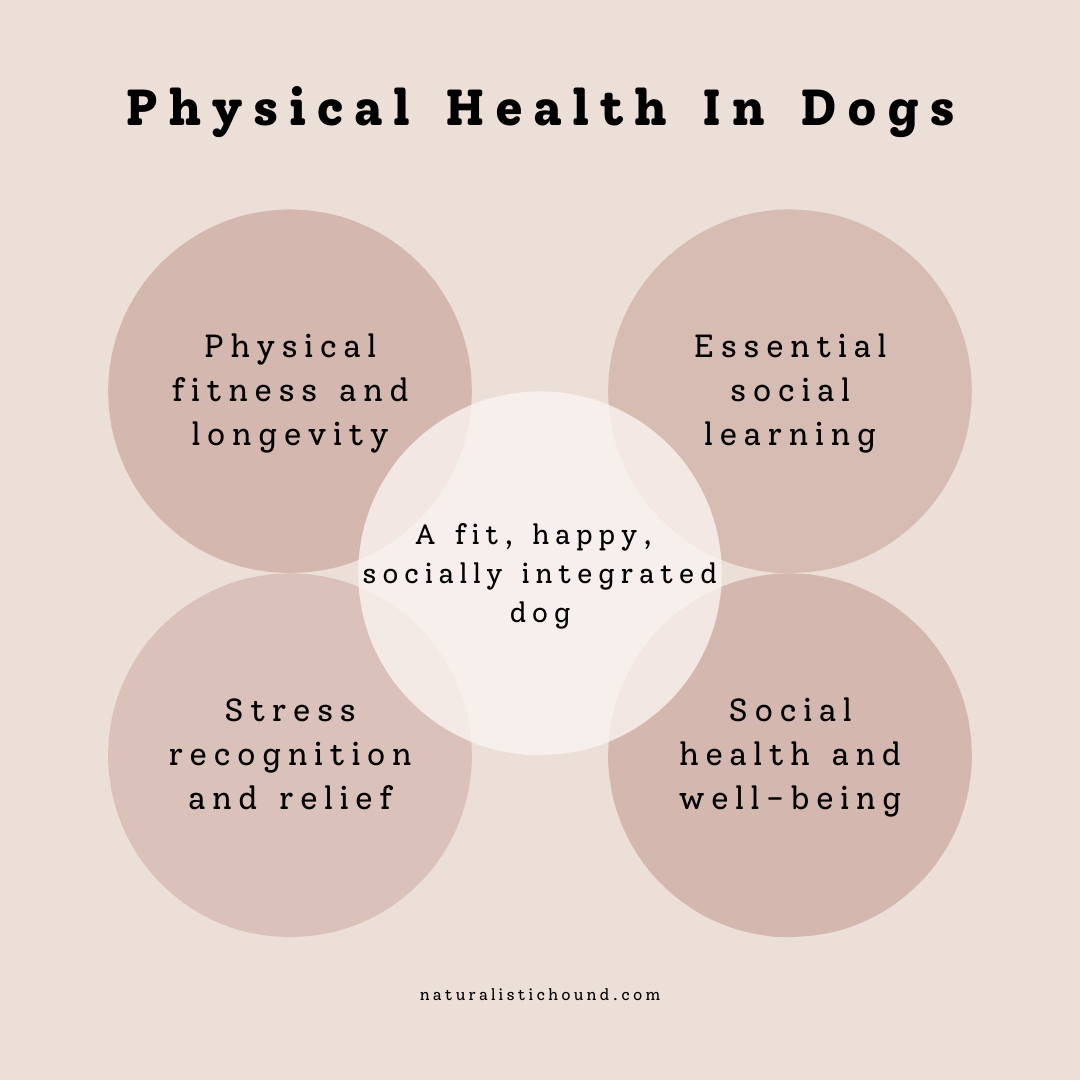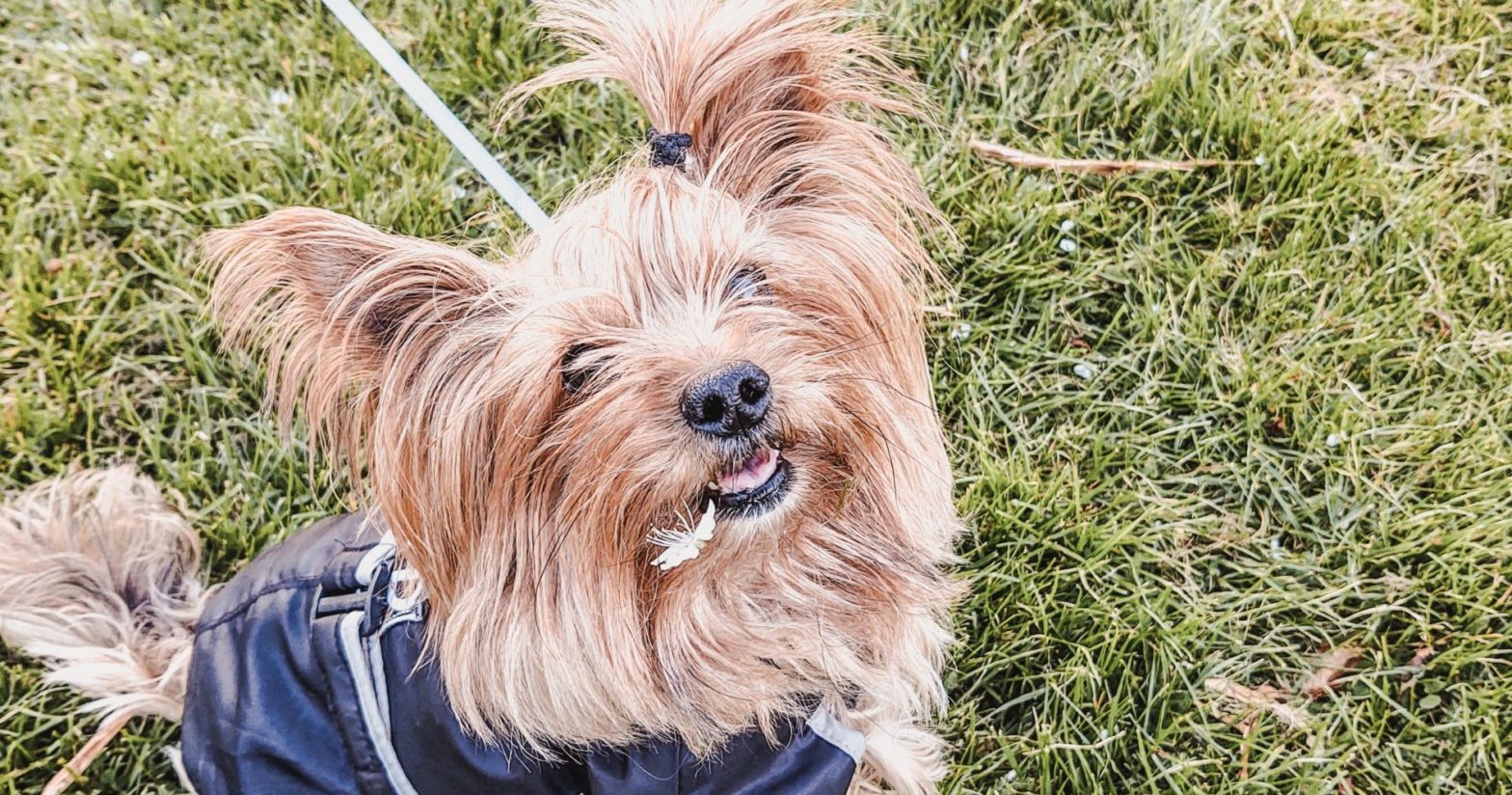Physical and Social Exercise is a necessary part of your dog’s well-being.
Going for walks is essential for dogs’ health: tones muscles, lubricates joints – which decreases pain and stiffness, and keeps heart and lungs fit.
This applies to every breed, from the smallest to the biggest. I often hear of very small dogs taken for walks once per week because the owners think “he is so small; he doesn’t need that much exercise!” – nothing could be more wrong.

Physical Exercise
The more muscles are used, the healthier they become and they will be able to cope easier with everyday movements without fatigue. Strong, toned muscles are ready for everything even while your dog is resting, making him stronger on an overall basis.
On the other hand, if a dog is not walked regularly, muscle tone will decline, especially as he ages, losing balance and strength. The joints will suffer too, as the body will rely more on tendons and joints without the support of strong muscles.
The heart is a muscle, which means it gets strengthened by both moderate and intense activity. Exercise improves the heart’s ability to pump blood to the lungs and throughout the dog’s body, including to the muscles. Capillaries widen during exercise and regular exercise keeps them wide. Capillaries are tiny blood-containing structures and they are the most abundant form of a blood vessel in the body, they are small enough to penetrate body tissues, allowing oxygen, nutrients, and waste products to be exchanged between tissues and the blood.
Weight maintenance is easier with regular physical activity.
When a dog puts on weight every area from body to mind suffer the consequences, especially if they reach obesity.
If a dog, for various reasons, is unused to exercise, he will need to be re-introduced gradually to prevent strain on the heart and generally on the body.
An exercised dog is a fit dog,
A fit dog is a healthy dog,
A healthy dog is a happy dog!
Social Exercise
Providing mental and social stimulation / exercise is just as important as physical exercise for your dog’s physical health.
Social learning, especially in puppies, is a vital part of your dog care.
Even with socialisation, some puppies can still develop fear issues later, this could be caused by a genetic trait or even the well-being of the mother whilst the puppy developed in the womb – but it is rarer than the result of poor socialisation during early stages of a dog’s life.
Socialized dogs are typically happier, more approachable, and able to handle stress better. Dogs that are not as socialized can become shy, anxious, and sometimes even aggressive out of fear because they do not have the social skills to deal with new situations or people.
Stress
Exercise relieves built up stress, however it is important to remember that dogs are individual and unique, and all have their own experiences, which means one dog may find relief in a certain type of exercise, while another may find the same activity incredibly stressful.
Stress is a fundamental element to keep under control because it can have catastrophic effects on your dog, it can affect the whole body, causing serious illnesses and long term stress can lead to fatal consequences.
Stress in dogs can be:
Short Term Stress
Your dog may see or hear something he fears or something totally new that frightens him, not being able to recognise it – and chemicals within his body will start unbalancing.
The stress hormone, Cortisol is released whenever your dog finds himself in a stressful situation. At the same time, all the other functions that are not crucial for a “fight or flight” reaction quickly shut down. Digestion, reproduction, and immunity slow down while adrenaline rushes to muscles and the heart rate increases.
As your dog start realising there is no longer danger or threat, his body starts to rebalance: cortisol production slows down and then eventually stops and body functions return to normal.
If this kind of reaction only occurs occasionally your dog will not suffer health issues.
Physical signs of a stressed dog are:
- yawning
- avoiding eye contact
- tail between legs
- licking lips
- ears pinned back
- heavy panting
- trying to leave the situation
- unresponsive
- whining
- growling
- aggression
- destructive behaviour
Ways To Relieve Short Term Stress In Dogs:
Exercise
Daily exercise is ideal for stress relief as it is proven to keep your dog happier and healthier for longer. Any physical activity like walking, playing, or swimming will work as long as it happens routinely every day.
“Doga”
“Doga” is a trending form of stress relief that is popular at the moment. Doga is when your dog participates in the dog version of yoga. This works perfectly as you can participate in the activity as well, giving you the option to attend the class too.
It is a way to increase activity and build a better connection between you and your pup.
Stress relief toys
These can work wonders. Things like specialized treats and unique toys can help to calm an anxious mind.
Calming music and sounds
Just like in humans, dogs can sense the calmness and tranquillity in music. Classical music or music that is gentle, will work best. Anything with lyrics should be avoided unless it is communicated calmly.
The best part of using relaxing music to help with anxious dogs is you can have the music playing even when you are away from home.
Self-check
Your dog picks up a lot of how they think & feel by your actions, even if that negative attitude is not towards them.
If you are going through a difficult time, then it is recommended to try and shield your dog from any explosive or violent swings in mood. This will help keep your dog in a more harmonious state for longer.
Once you have calmed down feel free to reach back out to your furry friend.
Limit social activity
It is common for dogs to set off stress and anxiousness when in public. Dogs react differently to having other dogs around them and not all are happy with lots of doggie friends.
Instead, keep your dog away from other dogs if he is feeling very stressed or limit the interaction with less intimidating dogs and breeds.
Spend more quality time
Sensitive dogs need more one on one time and nothing soothes a dog more than a good old-fashioned hug and rub by his favourite humans!
Try not to leave your dog along for too long
Leaving your dog alone for long periods during the day, especially when they are highly stressed, is a very bad idea. When you are forced to leave your dog alone, provide him with plenty of toys for stimulation. Try cognitive dog toys that force the dogs to work to receive treats from out of the toy. Chew toys may also help to soothe some dogs. All these toys will distract him during his time alone.
Alternately you can always rely on a loving yourlondonpetsitter.com sitter to provide the attention your little friend needs while you are gone.
Long Term Stress
Long term stress requires more attention as it can be very damaging.
Long term stress is the result of many short-term stress – episodes, which leave the body unable to rebalance itself and return to a normal state in between episodes.
On the long run stress will lead to a breakdown of the immune, reproductive, digestive, and circulatory system.
What is especially concerning is that this kind of stress is an abnormal state for a dog to live in, and yet it is very common in domestic pets because of the situations we put them in and what we expect from them.
Physical signs of a stressed dog are:
- licking or chewing on legs and paws
- regular stomach problems
- regular ear infections
- eating non-food items
- itchy dry skin and poor dull coat
- general behaviour issue
The first thing to do is to address the trigger of this underling stress and try to remove it.
Common causes for long term stress include:
Lifestyle – when a dog shows stress related problems, it is a good idea to look at the breed’s original function in comparison to the individual dog’s current life (for example a very active border collie who does not get exercised or mentally stimulated will very likely show long term stress signs)
Diet or infections – if a dog is fed a poor-quality diet with preservatives, allergens etc this will trigger often behaviour problems and stress related illnesses.
External factors – Dogs are very sensitive to changes and any change should be taken into consideration. (for example, a new pet in the household? Fireworks season?)
Exercise type and level – Dogs need enough exercise, but the right one. (for example, if a dog is scared of other dogs, taking him for a walk to a busy park it would not be a good idea)
Possible social issues – A dog that is not socially integrated can easily develop stress related issues; this is because he will fear many more things than necessary.
Your stressed passed onto your dog – Dogs are known for absorbing their owners’ stress and then developing their very own anxiety problems.
Treatment For Long Term Stress In Dogs:
Stress can be reversed; however, it takes a careful plan and some effort.
A general treatment may include:
- short term remedies to calm the stressed dog (veterinary medications)
- a behaviour modification program
- diet change
- exercise routine change
- herbal remedies
- massage therapy
Dogs have their own way to tell us what is bothering them, it is up to us to understand and translate their signals.
A Complete, Balanced & Personalised Diet
Naturalistic hound
for your Dog will Keep Him Happy and Healthy!
Click here to start your journey: Nutrition & Recipes

